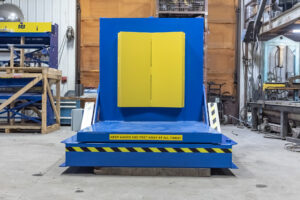While showing modest sequential growth, manufacturing output contracted for the fourth consecutive month, in February, according to the new edition of the Manufacturing Report on Business, which was issued today by the Institute for Supply Management (ISM).
The report’s key metric, the PMI, at 47.7 (a reading of 50 or higher indicates growth), eked out a 0.3% increase, from January to February, contracting, at a slower rate, for the fourth consecutive month. The last four months of contraction, through February, were preceded by a stretch of 29 consecutive months of growth. ISM also said that the overall economy contracted, at a slower rate, in February, for the third consecutive month, which was preceded by 30 consecutive months of growth.
The February PMI is 4.1% below the 12-month average of 51.8, with March 200 marking the high, for that period, at 57.0, and January 2023, at 47.4, marking the lowest.
ISM reported that four manufacturing sectors— Apparel, Leather & Allied Products; Transportation Equipment; Petroleum & Coal Products; and Electrical Equipment, Appliances & Components—saw growth in February. And 14 sectors saw February declines, including: Printing & Related Support Activities; Paper Products; Wood Products; Textile Mills; Furniture & Related Products; Nonmetallic Mineral Products; Plastics & Rubber Products; Food, Beverage & Tobacco Products; Chemical Products; Primary Metals; Computer & Electronic Products; Fabricated Metal Products; Machinery; and Miscellaneous Manufacturing.
The report’s key metrics were largely down in February, including:
New Orders, which are commonly referred to as the engine that drives manufacturing, increased 4.5%, to 47.0, but still contracted, at a slower, rate, for the sixth consecutive month, with three sectors reporting growth;
-Production, at 47.3, fell 0.7%, to 47.3, contracting, at a faster rate, for the third consecutive month, with four sectors reporting growth;
-Employment, at 49.1, fell 1.5%, contracted after growing in January, with six manufacturing sectors reporting employment growth;
-Supplier Deliveries, at 45.2 (a reading above 50 indicates contraction), grew at a faster rate, for the fifth consecutive month, following January’s 45.6 reading, with four sectors reporting slower deliveries in February (ISM said that the last three months indicate the fastest supplier delivery performance since March 2019, when it was at 43.2);
-Backlog of Orders, at 45.1, were up 1.7% compared to January, contracting, at a slower rate, for the fifth consecutive month, with two sectors reporting growth;
-Inventories, at 50.1, fell 0.1%, growing, at a slower rate, for the 19th consecutive month, with nine sectors reporting higher inventories;
-Customer Inventories, at 46.9, were down 0.5%, with four sectors reporting higher inventories; and
-Prices, at 51.3, rose 6.8%, increasing after four months of contraction, with eight sectors reporting higher prices
Comments submitted by the ISM member respondents again highlighted various themes related to the economy and market conditions.
“Sales remain solid, and most assembly plants are running at capacity. There is concern for the global supply chain now that we are restricting sales of some semiconductors to China,” said a Transportation Equipment respondent.
And a Fabricated Metal Products respondent said that new orders are still strong; however, his company continues to experience price increases (although at a slower rate than a year ago), which it has not accounted for in this year’s budget, adding that restoring lost margin due to cost increases is a top priority.”
Tim Fiore, Chair of the ISM’s Manufacturing Business Survey Committee, said in an interview that, as was the case in January, the February PMI was in close range to its expected estimate of 48-to-52.
“The PMI has been declining or contracting since August 2022, with February being the first month it has reversed that cycle, while not very strongly at three-tenths of a point,” he said. “It is primarily driven by the fact that new order levels came back up and are decreasing a little faster month-over-month but not at the same rate as in January. The 4.5% increase in new orders drove a 1.5% increase in the PMI. Overall, demand did very well.”
And he added that, from a demand perspective, February’s report checked off a lot of boxes, which could bode well for March. That was evident with February’s New Orders levels, as well as New Exports, at 49.9, and the Customer Inventories number, which Fiore said came in at the high end of its “too low” direction and is a positive and moving in the right direction. Another positive sign related to demand, Fiore noted, was Backlog of Orders slowing its rate of contraction by nearly 2%.
But for those concerned about inflation, he said there are causes for concern, in that companies that are able to pass price increases through are making more money in an inflationary environment.
“The only people worried too much about this, at this point, would be the Federal Reserve, in not hitting its objective,” he said. “Prices are pretty stable, with February’s increase not overly alarming, as prices have probably already hit the bottom in the current environment, with steel, copper, and aluminum on the way back up and probably what is driving this. The positive thing is that energy is stable, with chemical products being part of the problem area.
Looking at manufacturing on a year-to-date basis, Fiore referenced the ISM’s Semiannual Forecast issued in December, which indicated that the first six months of 2023 would be somewhat lumpy, or uneven, with the expectation that the second half of the year would be better.
“But now we are getting comments, which are hard to quantify, saying that maybe the first half lumpiness may stretch into some part of the second half,” he said. “That leads to a whole discussion around do you go really hard and have a shorter ‘recession’ or do you slowly come down and have a longer ‘recession?’ Right now, we are in that longer one. Rates went up in March 2022, and we are almost 12 months into it and have not seen a major decline. And we are starting to see things climb back up, with demand still strong, the unemployment level has not gone up and increased initial jobless claims.”
What’s more, Fiore said that going back to August 2022, manufacturing growth has been declining from growth to contraction. But when taking the August PMI reading through February, it is down only 3.5% over that seven-month period.
“Manufacturing is highly cyclical, so for a sector that is highly cyclical, we are not cycling,” he said. “Things are more stable than cyclical.”
Taking that a step further, he explained that when comparing sub-50 PMI readings to other periods, there are some notable takeaways.
The post 9/11 recession saw the PMI below 50 for 18 months, and the Great Recession in 2009 saw it under 50 for 11 months.
“I don’t think this one compares to either of those two, but those are the two I am most confident in because they are the recent ones,” he said. “Are we going to be in decline for another eight months, with February being the fourth month of contraction? It does not feel that way unless the Fed were to take additional action.”






